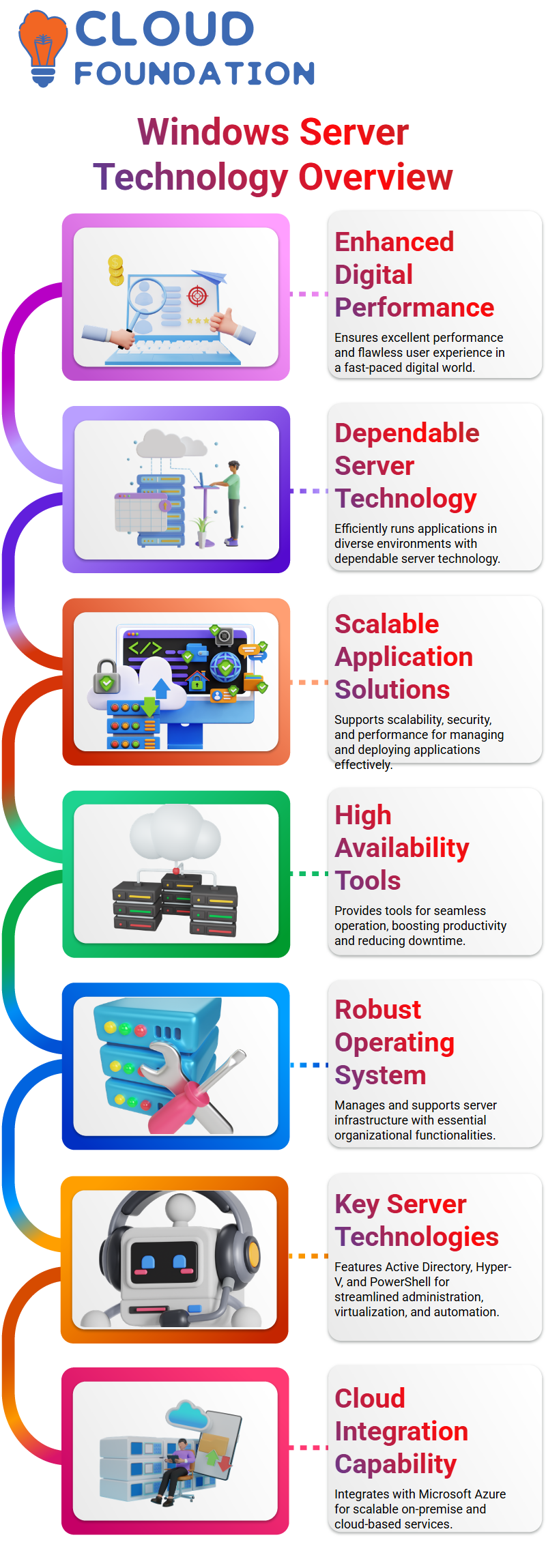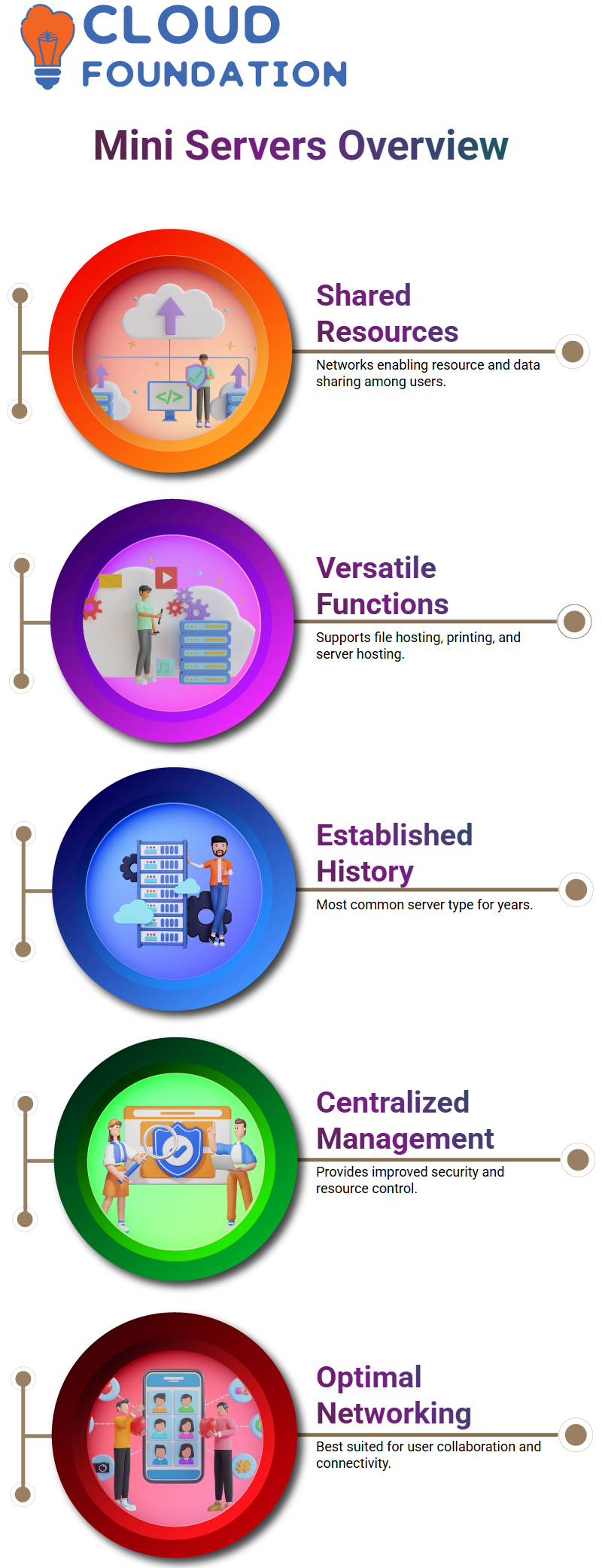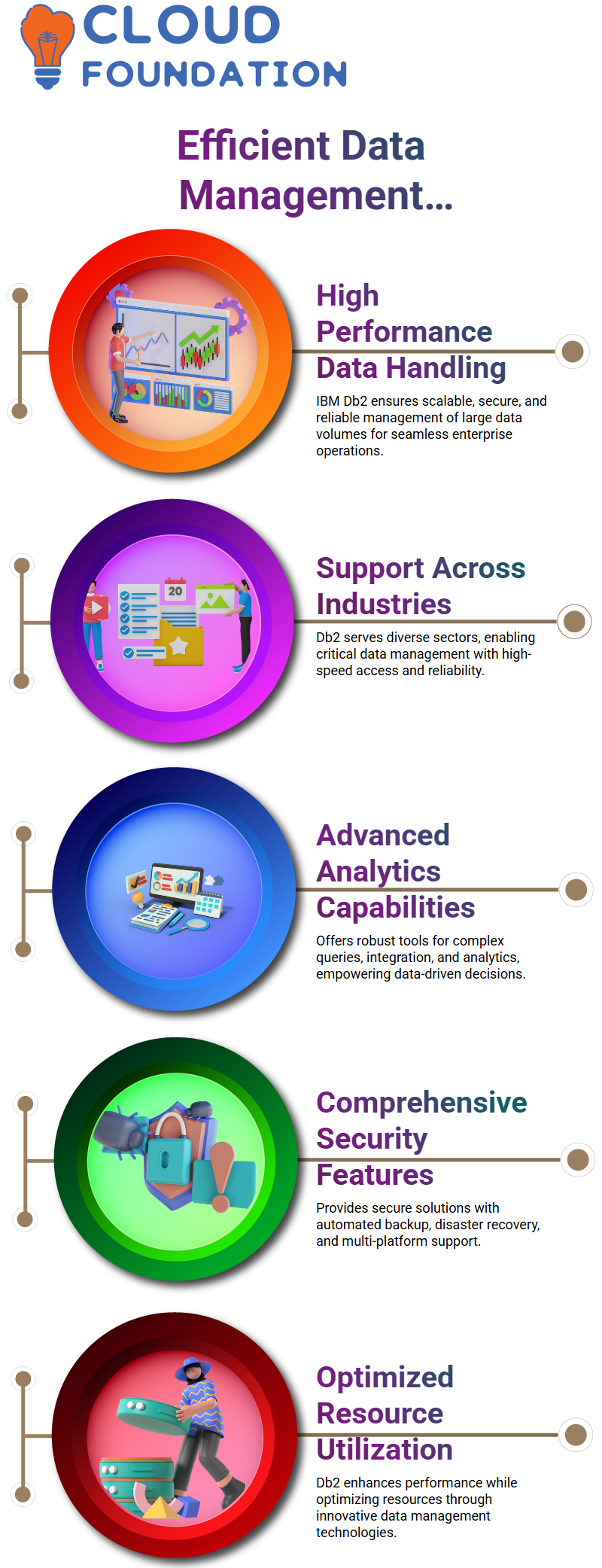Windows Server Tutorial
Introduction
To compete in the fast-paced digital world, organizations need excellent performance and a flawless user experience.
These aims require efficient and dependable server technology to run programs successfully in different situations.
Windows Server technology helps enterprises manage and deploy applications efficiently by providing scalability, security, and performance optimization solutions.
Windows Server helps IT teams maintain high availability and seamless operation with extensive network, storage, and user access tools, boosting productivity and reducing downtime.
Windows Server technology, the backbone of organizational infrastructure, is essential for building scalable, secure, and high-performance applications for modern digital business.
What is Windows Server?
Windows Server is a robust operating system designed by Microsoft to manage and support server infrastructure in organizations and corporations.

It includes crucial functions like as file sharing, database hosting, online services, and security management.
Windows Server’s key technologies are Active Directory for centralized user administration, Hyper-V for virtualization, and PowerShell for automation.
With its connection into Microsoft Azure, it also enables cloud-based services, allowing organizations to expand their operations both on-premise and in the cloud. Windows Server is critical for creating safe and scalable IT infrastructures.
Roles of a Server
Server roles are essential components of a company’s IT infrastructure, enabling it to perform various functions such as file servers, web servers, application servers, and more.
These roles can be performed as either as I or as I, with the most famous being print servers. Web servers offer remote access, while application servers can host applications for other users.
For example, if a company has a database managing company sales and customers, an application server is likely needed to host the database and manage the records.
Microsoft SQL is a famous example of a server that can host this database. Server or sequel servers are also important in Windows server administration.
Examples include email servers from Microsoft, which can act as exchange servers and can consider server rules to a server.
Edge transport rules are another type of server that acts as a server on the server, acting as a server on the edge network in the DMZ area.
This server is separated from the inner network, LAN network, and the internet by two firewalls to protect it.
Integration between the hub and transport servers is possible, as they are part of the transport server, exchange server, mail server, and internal Microsoft and internal network.
A server is a computer that provides services for users, such as web browsing or downloading a webpage.
A server can perform services for other computers while also providing source services from other servers. An example of a server is a computer that opens a web browser and searches for a specific topic.
The computer then sends a request to a web server hosting the webpage, which downloads the requested web page. The server then responds with a response, allowing the user to view the page.
The server and web server are similar in their client-server model, with the server performing the same tasks and responding to requests.
However, the server can also perform services for other computers while also requesting source services from other servers.
Mini Servers
Mini servers are a type of network that is based on shared resources and data between users. They perform various functions such as file hosting, print acting as print, and hosting servers.

These servers have been around for many years and are considered the most common type of server.
Server-based networks are the best for sharing resources and data between users, providing centralized security and management.
Active Directory in Windows Servers
The main server, called the active directory, is responsible for managing the database for users and computers over the network. This database controls and secures login credentials for every user and every con.
The Active Directory in Windows platforms has a maximum role for securing user data and computers.

The performance of these servers has become increasingly bitter over time. Windows Server 2016 or 2016 offers the best active directory practice, which is faster and more secure.
The Active Directory has a maximized role for securing user data and computers. It is bundled with another product, Microsoft Azure, which is directed to the cloud. If you are looking to continue with Microsoft, you will be continuing with Microsoft Azure.
Process of designing a server
The process of designing a server involves several steps, including giving people authorization, authenticating and authorizing them, and responding to their requests.
A server can have multiple roles and can perform multiple rules when designed. It is important to consider the server’s workload, the number of users it will serve, and the number of computers it will respond to.
Designing a server for a customer involves selecting the right server and choosing the right hardware and software.
Hardware is not an easy task, but it is crucial to choose the right hardware and software for the server. Research with the client and ask questions about the requirements, software types, and services they want to provide.
The server’s operating system is the framework that will be used to deploy applications or other solutions.
After completing the resources, the server operating system should be tested for compatibility between the server operating system and other servers.
This ensures that the server is compatible with the other servers and that the server can function properly.
When designing a server, it is essential to consider the workload, the number of users, and the number of computers it will serve. The server should be able to handle the load and provide service to the desired number of users.
The process of meeting with the customer involves researching the requirements, software types, and services provided through the server.
The server’s operating system is the framework that will be used to deploy the applications or solutions.
After completing the resources, the server operating system should be tested for compatibility with other servers and other systems.
Process of selecting a server hardware in Windows Server
The process of selecting a server hardware for a server operating system involves careful consideration of various factors.
The first step is to choose the appropriate hardware for the server, considering the number of users that will connect simultaneously to the server.
This includes the number of users who will be asking for services from the server and how many users will be asking for them.
The server hardware should be deployed in a server room, and the primary components that govern the server are the processor, memory storage, and network.
These components are crucial for a server technician to handle any potential failures.
When choosing a server solution, it is essential to consider the factors such as the number of users, the number of users who will be asking for services, the potential failure of the server, and the ability to deal with the failure. A server technician must also plan how to handle any potential failures and ensure that the server is functioning properly.
Another important aspect is the choice of the server hardware. The server hardware should be chosen carefully, considering the number of users that will be using the server at the same time and the number of users who will be asking for services.
Additionally, the server hardware should be designed to handle any potential failures, ensuring that the server is functioning properly and providing the desired service to its customers or clients.
Importance of Motherboard in Windows Server
The motherboard is a crucial component in a computer system, responsible for handling requests from the hard disk and transferring data between them to the processor.
This process is controlled by the chipset of the motherboard, which allows the processor to maximize its performance by connecting various components such as RAM, hard disk drives, and network interface cards.
The motherboard can be considered the nervous system of the computer, allowing it to perform mathematical and logical operations required by multiple processors.

It can also be considered the nervous system of the server, with its capabilities being generally expanded, including sound, network cards, graphic interface cards, video cards, and sound systems.
The network card can be built together with the network card, and even built in a graphic interface card or the Vega.
The video card can be expanded to include video and graphic interface cards, and the video and graphic interface card can be expanded even further.
For the multimedia server, more graphic interface cards can be installed, as well as sound systems and sound cards.
Computer’s memory system: RAM and the hard disk drive
The computer’s memory system is composed of two components: RAM and the hard disk drive. RAM, or random-access memory, is a short-term or temporarily stored memory that is different from hard memory.
It stores instructions and data that the processor can access directly. This data is stored on the hard disk drive and works as if it were directly accessed by the processor.
The amount of RAM used in a computer system is typically reflected to the entire server. This means that more RAM can generally store more data for the processor to handle and process.
However, adding more RAM can lead to a bottleneck of the processor, which can lead to slower performance.
When a computer is connected to the internet, the computer’s memory system can be affected by the amount of RAM it has. This can result in slower performance and decreased performance.
In addition to the memory system, the computer also has a network interface. This interface connects the computer to the internet and allows the user to access the computer’s resources. The computer also has a network interface that allows users to connect to the internet and access their devices.
The first hard disk drive was developed by IPM in the 20th century and was traditionally mechanical, half mechanical, and half electronic.
Data was half electronic, and data were stored on a magnetic field. Traditional hard disk drives included rotating disks and platters, which were used for data storage. Dell, another type of hard disk, is known as a “scuzzy hard disk.”
To understand the difference between these drives and other types of storage, one must attend a course or work in the field.
Mechanical hard disk drives have less capacity but are faster than their mechanical counterparts. Most personal computers typically have only one or two hard disks, while server platforms have server drives with direct attached storage.
These drives are designed to be faster than their mechanical counterparts but have less capacity. For direct storage, there are more than one hard disk drive if it’s connected to a computer or other storage device.
The development of hard disk drives has evolved over time, with different types of drives being developed and used for different purposes.
Microsoft Management Console (MMC) in Windows Server
The Microsoft Management Console (MMC) is a powerful tool that allows users to manage various devices, servers, disk drives, and authorizations for users.
To start the MMC, users can go to the Start menu of their server and type MMC or run the command MMC.
Administrative Tools are another important tool that Microsoft has provided since Windows NT. These tools are folders in control panels that contain tools for the system and administrators.

For example, users can find the active directory, the Bower shell, the PowerShell script to control the server, and the component services.
These tools allow users to monitor how services are running, their status, and any stops. The MMC also provides information on the amount of RAM and processing power consumed by these services.
Users can also run backup jobs through the MMC. Additionally, administrative tools allow users to control other services and services provided by other servers.
For example, the information internet can be managed as an active directory, while the information services is or the active information services is can be managed as an active directory.
To manage the task schedule, users can use the MMC command. This command allows users to schedule tasks for specific tasks, such as running a task on a specific server or executing a command on a specific server.
Conclusion
Windows Server technology is essential for enterprise IT infrastructure management. Businesses of all sizes can benefit from its Active Directory, Hyper-V virtualization, and seamless interaction with cloud services like Microsoft Azure.

Windows Server helps enterprises streamline operations, boost productivity, and respond to changing technology with strong automation, security, and scalability options.
Windows Server supports modern company needs and long-term growth on-premises or in the cloud with flexibility and stability.

G. Madhavi
Author
The capacity to learn is a gift the ability to learn is a skill the willingness to learn is a choice



